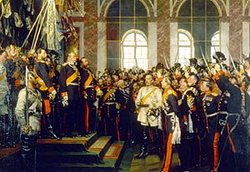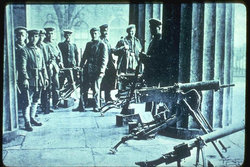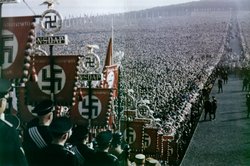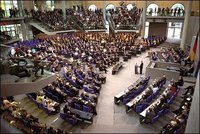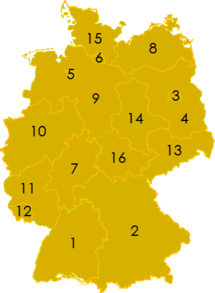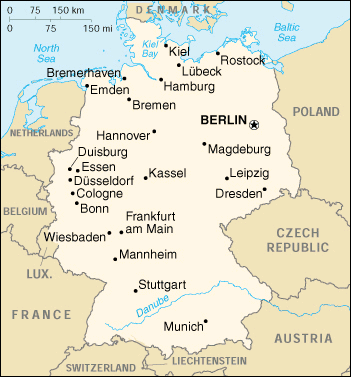Germany
|
|
The Federal Republic of Germany is one of the world's leading industrialised countries, located in the heart of Europe. It is bordered to the north by the North Sea, Denmark, and the Baltic Sea, to the south by Austria and Switzerland, to the west by France, Belgium, the Netherlands and Luxembourg, and to the east by Poland and the Czech Republic.
| |||||
| National motto: Einigkeit und Recht und Freiheit (German: Unity and Justice and Freedom) | |||||
| National anthem: Das Lied der Deutschen 3rd stanza (Einigkeit und Recht und Freiheit) | |||||
| Missing image LocationGermany.png Location of Germany | |||||
| Official language | German1 | ||||
| Capital | Berlin | ||||
| Largest City | Berlin | ||||
| Chancellor | Gerhard Schr? | ||||
| President | Horst K?r | ||||
| Area - Total - % water | Ranked 61st 349,223 km² 2.416% | ||||
| Population - April 2005 est - Density | Ranked 14th 82,468,000 [1] (http://www.destatis.de/indicators/e/vgr910ae.htm) 242/km² | ||||
| Formation Unification/reunification | Treaty of Verdun (843) January 18 1871 May 23 1949 October 3 1990 | ||||
| GDP - Total (2003) - GDP/capita | Ranked 3rd $2.271 trillion $27,600 | ||||
| Currency | Euro (€)2 | ||||
| Time zone - in summer | CET (UTC+1) CEST (UTC+2) | ||||
| Internet TLD | .de | ||||
| Calling Code | +49 | ||||
|
1 Danish, Low German, Sorbian, Romany and Frisian are officially recognised and protected as minority languages per the ECRML. | |||||
Germany is a democratic federal parliamentary state, made up of 16 federal states (L䮤er), which in certain spheres act independently of the Federation.
The Federal Republic of Germany is a member state of the United Nations, NATO, the G8 nations and a founding member of what is now the European Union.
| Contents |
History
Main article: History of Germany
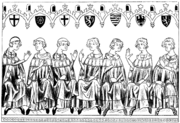
While the German language and the feeling of "Germanhood" go back more than a thousand years, the state now known as Germany was unified as a modern nation-state only in 1871, when the German Empire, dominated by the Kingdom of Prussia, was forged. This was the second German Reich, usually translated as "empire", but also meaning "realm".
Holy Roman Empire (843-1806)
The medieval empire – known for much of its existence as the Holy Roman Empire of the German Nation – stemmed from a division of the Carolingian Empire in 843, which was founded by Charlemagne on 25 December 800, and existed in varying forms until 1806, its territory stretching from the river Eider in the north to the mediterranean coast in the south. During these almost thousand years, the Germans expanded their influence successfully with the help of the Catholic Church, the Teutonic Order and the Hanseatic League. In 1530, the attempt of the Protestant Reformation of Catholicism turned out to have failed, and a separate Protestant church was acknowledged as new state religion in many states of Germany. This led to inter-German strife, the Thirty Years War (1618) and finally the Peace of Westphalia (1648), that resulted in a drastically enfeebled and politically disunited Germany, unable to resist the stroke of the Napoleonic Wars, during which the imperium was overrun and dissolved (1806). The lasting effect of the dissolution of the Holy Roman Empire came to be the division between Austria, formerly the leading state of Germany, from the more western and northern parts.
Restoration and revolution (1814-1871)
800px-Nationalversammlung.jpg
Following Napoleon's fall, the Congress of Vienna convened in 1814 in order to restructure Europe. In Germany, the German Confederation was founded, a loose league of 39 sovereign states. Disagreement with the restoration politics partly led to the lifestyle called Biedermeier and to intellectual liberal movements, which demanded unity and freedom during the Vorm䲺 epoch each followed by a measure of Metternich repressing the liberal agitation. The Zollverein, a tariff union, profoundly furthered economic unity in the German states.
The states also started to be shaped by the Industrial Revolution, which was the first step of the growing industrialization and contributed to a wave of pennilessness in Europe causing social uprisings. In the light of a series of revolutionary movements in Europe, which in France successfully established a republic, intellectuals and common people started the Revolutions of 1848 in the German states. The monarchs initially yielded to the revolutionaries' liberal demands and an intellectual National Assembly was elected to draw up a constitution for the new Germany, completed in 1849. However, the Prussian king Frederick William IV, who was offered to become Emperor but lose power, rejected crown and constitution. This prompted violent rollbacks by the monarchs, and the demise of the national assembly along with most merits of the revolution.
In 1862, conflict between the Prussian King Wilhelm I and the increasingly liberal parliament erupted over military reforms. The king appointed Otto von Bismarck the new Prime Minister of Prussia, who used the desire for national unification to further the interests of the Prussian monarchy. He successfully waged war on Denmark, on Austria and, finally, on France.
German Empire (1871-1918)
After the French defeat in the Franco-Prussian War, the German Empire (Kaiserreich) was proclaimed in Versailles on January 18, 1871. Virtually a result of the wars, the Empire was a unification of the scattered parts of Germany but without Austria—Kleindeutschland. Later, colonies were established. After 1888, the Year of Three Emperors, Bismarck was forced to quit by the young new Emperor William II in 1890 due to political and personal differences. The Emperor's foreign policy was opposed to that of Bismarck, who had established a system of alliances in the era called Gr?eit securing Germany's position as a great nation and avoiding war for decades. Under Wilhelm II Germany took an imperialistic course, not unlike other powers, but it led to friction with neighbouring countries. Most alliances in which Germany had been involved were not renewed and new alliances excluded the Reich. Austria and Germany became increasingly isolated.
Although not one of the main causes, the assassination of Austria's crown prince triggered World War I on 28 July 1914, which saw Germany as part of the unsuccessful Central Powers in the second-bloodiest conflict of all time against the Allied Powers. In November 1918, the German Revolution broke out (starting with a mutiny at Kiel), and Emperor William II and all German ruling princes abdicated. An armistice was signed on November 11 putting an end to the war. Germany was forced to sign the Treaty of Versailles in 1919, whose unexpectedly high demands and humiliating aspects were perceived as a continuation of the war with other means in Germany.
Weimar Republic (1919-1933)
After the German Revolution on November 1918, a Republic was proclaimed. That year, the German Communist Party was established, and on January 1919 the German Workers Party, later known as the National Socialist German Workers Party (NSDAP). On August 11, 1919, the Weimar Constitution came into effect.
The democracy was made unpopular in part because of the economic hardship due to both the world wide Great Depression and the harsh peace conditions dictated by the Treaty of Versailles. The German voters increasingly supported anti-democratic parties, both right- and left-wing. In the two extraordinary elections of 1932, the anti-democratic Nazis got 37.2 per cent and 33.0 per cent.
A series of dramatic events marked the end of the Weimar Republic. On 30 January, 1933, President von Hindenburg appointed Adolf Hitler Chancellor of Germany. On February 27th, the Reichstag was set on fire. Basic rights were abrogated under an emergency decree. An Enabling Act gave Hitler's government full legislative power. A centralised totalitarian state was established, no longer based on the rule of law.
Third Reich (1933?1945)
The new regime quickly dissolved all trade unions, made Germany a one-party state, and repressed all opposition. From 1933 onwards, 412 concentration camps were set up for groups and people perceived as threats. Open persecution of Jews began, culminating in Kristallnacht on November 9 1938. In 1934, the Nazi Party was purged of internal opposition during the Night of the Long Knives. In 1935 the Nuremberg race laws came into force: Jews were deprived of their German citizenship, banned from marrying Germans, and locked out from most of society.
In 1936, German troops entered the demilitarised Rhineland, violating the Versailles Treaty, in an attempt to rebuild national self-esteem. Emboldened, Hitler followed from 1938 onwards a policy of expansionism. It started with the annexation of Austria and the Sudetes region in Czechoslovakia. In 1939, Bohemia and Moravia were annexed and a Slovakian independent state was created. To avoid a two-front war, the Molotov-Ribbentrop Pact was concluded with the Soviet Union. Then Germany launched a Blitzkrieg against Poland, beginning World War II.
In 1940, most of Western Europe was occupied, and Germany continued its invasions through 1941, conquering Yugoslavia and Greece, engaging in the Battle of Britain over London, and then breaking the pact with the Soviet Union by opening the Eastern Front. When war was also declared on the United States after Japan's attack on Pearl Harbor, Hitler had engaged too many enemies. The Soviet Union started to push Germany back and German cities increasingly became targets of Allied air attacks. On May 8 1945, Germany surrendered after the Red Army had occupied Berlin, where Hitler had committed suicide. Under his leadership, Nazi Germany had systematically murdered six million Jews in the Holocaust and six million more Roma, Slavs, homosexuals, communists, Jehovah's Witnesses, and mentally and otherwise disabled individuals.
Division and reunification (1945-1990)
Berlin-wall-dancing.jpg
The war resulted in territorial losses and the expulsion of millions from Silesia, Prussia and Pomerania, as well as from Bohemia and Moravia. Germany and Berlin were occupied and partitioned by the Allies, with West Germany and West Berlin being controlled by the Western allies and East Germany and East Berlin by the Soviet Union. When the Soviet Union cut off supplies to West Berlin, Western forces airlifted food and supplies.
West Germany benefitted from the American Marshall Plan for the reconstruction of Europe after the war and was a founding state of the European Union. Its economy bloomed and democracy was stabilised by successive governments in Bonn.
The Soviet-supported East Germany, by contrast, became one of the most repressive of the communist satellite states of the Warsaw Pact. The flight of growing numbers of East Germans to freedom via West Berlin led on August 13, 1961, to East Germany erecting the Berlin Wall and a fortified border to West Germany.
Relations between the Federal Republic of Germany and the GDR remained icy until the Western chancellor Willy Brandt launched a highly controversial rapproachment with East Berlin and Moscow (Ostpolitik) in the 1970's.
During the summer of 1989, following growing unrest, large numbers of East German citizens took refuge in West German embassies in Central and Eastern European countries in the hope of emigrating to the West. The East German government's confusion grew and on November 9 1989, East German authorities unexpectedly allowed East German citizens to enter West Berlin and West Germany. Hundreds of thousands of people took advantage of the opportunity; new crossing points were opened in the Berlin Wall and along the border with West Germany. This led to the acceleration of the process of reforms in East Germany that ended with the reunification of East and West Germany that came into force on October 3 1990.
Politics
National government
Main article: Politics of Germany
Germany is a constitutional federal republic, whose political system is laid out in the 1949 constitution called Grundgesetz (Basic Law). It has a parliamentary system in which the head of government, the Bundeskanzler (Federal Chancellor), is elected by the parliament.
Head of state. The function of head of state is performed by the Federal President (Bundespr䳩dent). He is elected every five years by the Federal Assembly (Bundesversammlung), which is made up by the members of the Bundestag plus the corresponding number of L䮤er (states) representatives. The powers of the Federal President are mostly limited to ceremonial and representative duties, but the signature of the President is required for laws to become effective.
Herrenhaus-berlin.jpg
Parliament. The German legislature consists of the Bundestag and the Bundesrat. The supreme legislative body is the Bundestag (Federal Diet), the lower house of Parliament, which is elected every four years. It in turn elects the Federal Chancellor (Bundeskanzler). The Bundesrat (Federal Council), the upper house of Parliament, represents the 16 federal states (Bundesl䮤er) and cooperates in law-making and administering the federation. Its members are appointed by the individual L䮤er, or states. Lately, there has been much concern about the Bundestag and the Bundesrat blocking each other, especially with majorities differing in the two bodies, making effective legislation very difficult.
Legal system
Main article: Judiciary of Germany
Preamble_Grundgesetz.jpg
Germany has a civil or statute law system based ultimately on Roman law. Legislative power is divided between the Federation and the individual federated states. While criminal law and private law have seen codifications on the national level (in the Strafgesetzbuch and the B?iches Gesetzbuch respectively), no such unifying codification exists in administrative law where a lot of the fundamental matters remain in the jurisdiction of the individual federated states. There are a series of specialist supreme courts; for civil and criminal cases the highest court of appeal is the Bundesgerichtshof (Federal Court of Justice). The courtroom style is inquisitorial.
The Federal Constitutional Court (Bundesverfassungsgericht), located in Karlsruhe, is the supreme court responsible for constitutional matters, with power of judicial review. It acts as the highest legal authority and ensures that legislative and judicial practice conforms with the Basic Law. It acts independently of the other state bodies but cannot act on its own behalf.
Foreign relations
Main article: Foreign relations of Germany
Schr?andChirac.jpg
Together with France, Germany plays a leading role in the European Union. Germany is at the forefront of European states seeking to advance the creation of a more unified and capable European political, defence and security apparatus.
Since its establishment on May 23, 1949, the Federal Republic of Germany kept a notably low profile in international relations. In 1999, however, on the occasion of the NATO war against Yugoslavia, Chancellor Gerhard Schr?'s government broke convention by sending German troops into combat for the first time since World War II.
In 2003, Germany and France were protagonists in the coalition of nations opposing the US-led war in Iraq. Nevertheless, the German government has offered help to the reconstruction efforts in Iraq, but only outside of the war-torn country. In 2004, German troops stationed in the United Arab Emirates trained 122 Iraqi soldiers to drive and maintain military trucks. In April 2005, the German military sent around 50 German soldiers and 19 translators to Abu Dhabi to show 85 Iraqis how to build bridges and streets.
Together with Japan, India, and Brazil, Germany is currently seeking a permanent seat on the UN Security Council.
Armed forces
Eufor_handover.jpg
Main article: Military of Germany
Germany's military, the Bundeswehr, is a federal defence force with Army Heer, Navy Deutsche Marine, Air Force Luftwaffe, Central Medical Services (Zentraler Sanit䴳dienst) and Joint Service Support Command (Streitkr䦴ebasis) branches. It employs some 250,000 personnel, 50,000 of whom are 18-30-year-old men on national duty for currently at least 9 months. In peacetime, the Bundeswehr is commanded by the Minister of Defence, currently Peter Struck (since 2002). If Germany is in a state of defence, the Federal Chancellor becomes commander in chief of the Bundeswehr.
The military budget has not kept up with the Bundeswehr's mission, which has changed dramatically from protecting Germany's borders against a Soviet invasion into a mobile unit deployed around the world. The funding levels for the Bundeswehr have actually been falling since 1990, when military spending amounted to about 3.5 per cent of gross domestic product. Today, defence spending equals about 1.6 per cent of German GDP, compared to the NATO average of 2.1 per cent and the United States' 3 per cent. Critics argue that the current budget of €24.4 billion is too small to finance the necessary transformation of the Bundeswehr into a well-equipped force ready for NATO and UN led missions abroad.
Currently, the German military has about 1,180 troops stationed in Bosnia-Herzegovina; 2,650 Bundeswehr soldiers are serving in Kosovo; 3,900 Bundeswehr troops are assisting the US anti-terrorism operation called Enduring Freedom off the Horn of Africa. In Afghanistan, 2,100 German troops currently make up the largest contingent of the NATO-led ISAF force.
Geography
Main article: Geography of Germany
States
Main article: States of Germany
Germany is divided into sixteen states (in German called Bundesl䮤er, singular Bundesland). It is further subdivided into 439 districts (Kreise) and cities (kreisfreie St䤴e) (2004).
| In English | In German | ||||||
|---|---|---|---|---|---|---|---|
| State | Capital | State | Capital | ||||
| 1 Baden-W?berg | Stuttgart | Baden-W?berg | Stuttgart | ||||
| 2 Bavaria | Munich | (Freistaat) Bayern | M? | ||||
| 3 Berlin | Berlin | Berlin | Berlin | ||||
| 4 Brandenburg | Potsdam | Brandenburg | Potsdam | ||||
| 5 Bremen | Bremen | (Freie Hansestadt) Bremen | Bremen | ||||
| 6 Hamburg | Hamburg | (Freie und Hansestadt) Hamburg | Hamburg | ||||
| 7 Hesse | Wiesbaden | Hessen | Wiesbaden | ||||
| 8 Mecklenburg-Western Pomerania | Schwerin | Mecklenburg-Vorpommern | Schwerin | ||||
| 9 Lower Saxony | Hanover | Niedersachsen | Hannover | ||||
| 10 North Rhine-Westphalia | D?orf | Nordrhein-Westfalen | D?orf | ||||
| 11 Rhineland-Palatinate | Mainz | Rheinland-Pfalz | Mainz | ||||
| 12 Saarland | [[Saarbr?] | Saarland | - | 13 Saxony | Dresden | (Freistaat) Sachsen | Dresden |
| 14 Saxony-Anhalt | Magdeburg | Sachsen-Anhalt | Magdeburg | ||||
| 15 Schleswig-Holstein | Kiel | Schleswig-Holstein | Kiel | ||||
| 16 Thuringia | Erfurt | (Freistaat) Th?n | Erfurt | ||||
Territory
Since reunification of the two parts of the country Germany has resumed its role as a major centre between Scandinavia in the north and the Mediterranean region in the south, as well as between the Atlantic west and the countries of central and eastern Europe.
The territory of Germany stretches from the high mountains of the Alps (highest point: the Zugspitze at 2,962 m) in the south to the shores of the North Sea in the north-west and the Baltic Sea in the north-east. In between are found the forested uplands of central Germany and the low-lying lands of northern Germany (lowest point: Neuendorfer/Wilstermarsch at 3.54 meters below sea level), traversed by some of Europe's major rivers such as the Rhine, Danube and Elbe.
Thanks to its central situation Germany has more neighbours than any other European country; these are Denmark in the north, Poland and the Czech Republic in the east, Austria and Switzerland in the south, France and Luxembourg in the south-west and Belgium and the Netherlands in the north-west.
Climate
The greater part of Germany lies in the cool/temperate climatic zone in which humid westerly winds predominate.
In the north-west and the north the climate is extremely oceanic and rain falls all the year round. Winters there are relatively mild and summers comparatively cool.
In the east the climate shows clear continental features; winters can be very cold for long periods, and summers can become very warm. Here, too, long dry periods are often recorded.
In the centre and the south there is a transitional climate which may be predominantly oceanic or continental, according to the general weather situation.
Economy
Main article: Economy of Germany
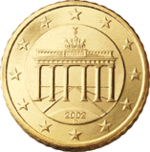
Germany is the world's third largest economy measured by gross domestic product, placed behind the United States and Japan. According to the World Trade Organisation, Germany is also the world's top exporter, ahead of the United States and China. Its major trading partners include France, the United States, the United Kingdom, Italy and the Netherlands. A major issue of concern remains the persistently high unemployment rate, especially in the eastern states, and weak domestic demand which slows down economic growth. However, according to Bert R?head of Germany's Council of Economic Advisers, reunification is to blame for two-thirds of Germany's growth lag compared to its EU neighbours. In particular, until today eastern Germany lacks a solid base of small and medium-sized companies, which provided the foundation for West Germany's economic prosperity.
Agriculture
For many years now agriculture in Germany has been in a state of decline. Poor earnings and lack of profitability are counted to the main reasons for the failure of many medium and small concerns. The main crops grown are potatoes, wheat, barley, sugar beet and cabbage. Germany ranks among the world's largest producers of milk, milk products and meat.
Industrial sector
As in most other large economic nations, Germany's industrial sector has declined in favour of the service sector. Germany is among the world's largest and most technologically advanced producers of iron, steel, cement, chemicals, machinery, motor vehicles, machine tools and electronics, as well as a world leader in the shipbuilding industry. Major automakers like DaimlerChrysler and Volkswagen, and huge international corporations like Siemens AG rank among the world's largest firms.
Service sector
The service sector has grown steadily in recent years and now contributes the largest share of GDP. This sector includes tourism. As of 2004, the largest numbers of foreign visitors to Germany came from the Netherlands, followed by the United States and the United Kingdom.[2] (http://www.destatis.de/basis/e/tour/tourtab4.htm)
Natural resources
Germany is lacking in natural raw materials, if one disregards the hard coal deposits in the Ruhr area, in the Aachen district and in the Saarland, where mining is profitable only thanks to state subsidies. Brown coal from mines in the Leipziger Bucht and the Niederlausitz is still the major energy source in the eastern L䮤er, while mineral oil enjoys this position in the western L䮤er. The current red-Green coalition government is pursuing a long-term strategy of phasing out nuclear power in favour of renewable sources of energy.
Society
Demographics
Main article: Demographics of Germany
Hamburg_old.jpg
Germany has many large cities but only three with a population of one million or more: Berlin with 3.4 million, Hamburg with 1.8 million, and Munich with 1.4 million. Thus, the population is much less centralised and oriented towards a single large city than in most other European countries. The largest cities apart from those are Cologne (K?, Frankfurt am Main, Stuttgart, Dortmund, Essen, D?orf, Bremen, Duisburg and Hanover (Hannover). By far the largest urban conurbation is the Rhine-Ruhr region, including the D?orf-Cologne district.
As of 2004, about 6.7 million non-citizen residents were living in Germany. By far the largest number came from Turkey, followed by Italy, Greece, Croatia, the Netherlands, Serbia and Montenegro, Spain, Bosnia and Herzegovina, Austria, Portugal, Vietnam, Morocco, Poland, Macedonia, Lebanon and France. [3] (http://www.destatis.de/basis/e/bevoe/bevoetab10.htm) About 2/3 of these have been in the country for 8 years or more, and are therefore eligible for naturalization.[4] (http://www.destatis.de/basis/e/bevoe/bevoetab8.htm)
Germany is still a primary destination for political and economic refugees from many developing countries, but the number of asylum seekers has been dropping in recent years, reaching about 50,000 in 2003.
An ethnic Danish minority of about 50,000 people lives in Schleswig, mostly close to the Danish border, in the north; a small number of Slavic people known as the Sorbs lives in the states of Saxony (about 40,000) and Brandenburg (about 20,000). The Frisian language is mother tongue to about 12,000 speakers in Germany. In rural areas of Northern Germany, Low Saxon is widely spoken.
There are also a large number of ethnic German immigrants from the former Soviet Union area (1.7 million), Poland (0.7 million) and Romania (0.3 million) (1980–1999 totals), who are automatically granted German citizenship, and thus do not show up in foreign resident statistics; unlike foreigners, they have been settled by the government almost evenly spread throughout Germany.
Religion
Main article: Religion in Germany
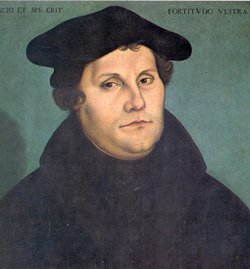
Germany is the home of the Reformation launched by Martin Luther in the early 16th century. Today, Protestants (particularly in the north and east) comprise about 33% of the population and Catholics (particularly in the south and west) also 33%. In total more than 55 million people officially belong to a Christian denomination. Most German Protestants are members of the Evangelical Church in Germany. Free churches exist in all larger towns and many smaller ones, but most such churches are small. The current pontiff of the Roman Catholic Church, Pope Benedict XVI, is German.
Besides this there are several hundred thousand Orthodox Christians (mostly Greeks and Serbs), 400,000 New Apostolic Christians, 150,000 Jehovah's Witnesses, and numerous other small groups.
Approximately 3.7 million Muslims (mostly of Turkish descent) live in Germany.
Germany now has Europe's third-largest Jewish population. in 2004, twice as many Jews from former Soviet republics settled in Germany as in Israel, bringing the total influx to more than 200,000 since 1991. About half joined a settled Jewish community, of which there are now more than 100, with a total of 100,000 members—up from 30,000 before unification. Some German cities have seen a revival of Jewish culture, particularly in Berlin, where 3,000 Israelis also live. Jews have a voice in German public life through the Zentralrat der Juden in Deutschland.
In the territory of the former East Germany, there is much less religious feeling—probably the result of forty years of Communism—than in the West. Only 5% attend a mass at least once per week, compared with 14% in the West according to a recent study (http://www.umich.edu/~newsinfo/Releases/1997/Dec97/r121097a.html). About 30% of the total population are officially religiously unaffiliated. In the East this number is also considerably higher.
Church and state are separate, but there is cooperation in many fields, most importantly in the social sector. Churches and religious community, if they are both large, stable and loyal to the constitution, can get special status from the state as a "corporation under public law" which allows the churches to levy taxes called Kirchensteuer (church tax) on their members. This revenue is collected by the state in return for a collection fee. See Status of religious freedom in Germany.
Education
Main article: Education in Germany
Germany has one of the world's highest levels of education. The most important foreign languages taught at school are English, Latin, French, Russian, Greek, and Spanish. Since the end of World War II, the number of youths entering universities has more than tripled, but university attendance still lags behind many other European nations. In the annual league of top-ranking universities compiled by Shanghai Jiaotong University in 2004, Germany came 4th overall, but with only 7 universities in the top 100 (to compare, the United States had 51). The highest ranking university, at #45, was the TU Munich.
For Germany, the results of the PISA student assessments were some kind of nationwide shock. The comparatively low scores brought on heated debate about how the school system should be changed. Furthermore it was revealed that more than in other countries students with higher-earning parents are better-educated and tend to achieve higher results. There is also some diversity between the schools of the various states, that determine their respective school system independently.
In addition to academic education, Germany also has a elaborate system of vocational education, called the dual system, which combines apprenticeship in enterprises with theoretical teaching in vocational schools.
Germany prohibits home-schooling, however, this is still practised by a number of people; there has been some publicity to government prosecution of this practice.
Social issues
Main article: Social issues in Germany
The German social market economy (German: soziale Marktwirtschaft) helped bring about the "economic miracle" that rebuilt Germany from ashes after World War II to one of the most impressive economies in Europe.
Still, Germany continues to struggle with a number of social issues. Issues created by the German Reunification of 1990 have begun to narrow. While the standard of living is higher in the western half of the country, easterners now share a reasonably high standard of living. Germans continue to be concerned about a relatively high level of unemployment; however, they are generally unwilling to concede to labour concessions such as longer working hours.
Since World War II, Germany has experienced intermittent turmoil from various extremist groups. In the 1970s the terrorist Red Army Faction engaged in a string of assassinations and kidnappings against political and business figures. Recently there has been a surge in right-wing extremist crimes. According to Interior Minister Otto Schily, the number of these crimes rose 8.4% to 12,553 cases in 2004, which the minister attributed to such crimes as the display of illegal Nazi symbols.
In September 2004, the right-wing extremist National Democratic Party gained a new place on the national political stage when they captured 9.2% of the vote in the eastern state of Saxony. That compared with 1.9% in 1999. The current German government considers this party to be a threat to the country and has sought repeatedly to ban the party or curtail its activities.
Immigrants in Germany face undue police inquiries (such as repeat targeted requests for identification), violence from right-wing extremist groups, higher rates of delinquency and more general integration problems. Some German states have banned Muslim teachers from wearing headscarves in class.
Culture
Main article: Culture of Germany
Goethecut.png
Germany's contributions to the world's cultural heritage are numerous, and the country is often known as das Land der Dichter und Denker (the land of poets and thinkers). German literature can be traced back to the Middle Ages, in particular to such authors as Walter von der Vogelweide and Wolfram von Eschenbach. The Nibelungenlied, whose author is not known, is also a major contribution to German literature. Theologian Luther, who translated the Bible into German, is widely credited for having set the basis for modern "High German" language. The mostly admired German poets and authors are without doubt Goethe and Schiller, as well as Heine and, in the 20th century, Nobel prize winners Bertold Brecht and G?Grass. Other authors include Hesse, Mann, [[Heinrich B?B?] and Enzensberger. Germany's influence on world philosophy was major as well, as exemplified by Leibniz, Kant, Hegel, Marx, Engels, Schopenhauer, Nietzsche and Heidegger.
In the field of music, Germany's influence is noted through the works of Bach, Beethoven, Brahms, Schumann, Orff and Wagner.
In the arts, there are several fine German painters such as the Renaissance artist [[Albrecht D??, the romanticist Friedrich, the surrealist Ernst, the expressionist Marc, the conceptual artist Beuys or the neo expressionist Baselitz. Architecture also flourished in Germany. Several UNESCO World Heritage Sites are scattered throughout Germany (including, for instance, the cathedral of Cologne and the Museum Island in Berlin). Famous architects include neoclassicist Schinkel and Gropius, the founder of the Bauhaus.
Germany was also the homeland of scientists like Helmholtz, Fraunhofer, Fahrenheit, Kepler, Haeckel, Humboldt, Einstein, Born, Planck, Heisenberg, Creuzfeldt, Hertz, Koch, Hahn, Leibniz, Liebig and Bunsen; and inventors and engineers such as Gutenberg, Otto, Siemens, Braun, Daimler, Benz and Diesel.
Important mathematicians were born in Germany such as Bessel, Euler, Gauss, Hilbert, Jacobi, Riemann and Weierstrass.
Many historical figures, though not citizens of Germany in the modern sense, were important and influential figures in German culture, such as Wolfgang Amadeus Mozart, Franz Kafka and Stefan Zweig.
The German language was once the lingua franca of central, eastern and northern Europe, and in Europe it is the second most popular language after English. Within the European Union, German is the most spoken language before English, French, Spanish and Italian. As a foreign language, German is the third most taught worldwide. [5] (http://www.auswaertiges-amt.de/www/en/aussenpolitik/kulturpolitik/sprache/deutsch_html). It is also the second most used language on the Internet. The language has its origin in Old High German. Germany had two languages: High German and Low German, which—from a linguistic standpoint—were two different languages. Whilst High German was subject to the so-called High German consonant shift, Low German was not. Today's standard language is based on High German rather than Low German; the latter has been given the status of a minority language by the European Union, although it is less used today in the traditionally Low German-speaking areas of northern Germany.
Since about 1970 Germany has once again had a thriving popular culture, now increasingly being led by its new old capital Berlin, and a self-confident music and art culture. Germany is also well known for its many opera houses, the most famous of which being located in Bayreuth.
Maps of Germany
Pictures of Germany
Miscellaneous topics
- List of Germans
- List of German towns
- List of German districts
- List of universities in Germany
- GermNews
- Historical Eastern Germany
- Communications in Germany
- Transportation in Germany
- Tourism in Germany
- Tax in Germany
- List of famous Germans
- List of English exonyms for German toponyms
- Nazi architecture
References
- References and bibliography can be found in the more detailed articles linked to in this article.
External links
- Facts about Germany (http://www.facts-about-germany.de) — Official site published by the German Federal Foreign Office
- Deutschland.de (http://www.deutschland.de/home.php?lang=2) — Official German portal
- campus-germany.de (http://www.campus-germany.de) — Study and Research in Germany (multilingual)
- Deutsche Welle (http://www.dw-world.de) Germany's international broadcaster, 30 language website
- Pictures of Germany (http://www.earth-photography.com/Countries/Germany) From the countryside to large cities
- Destatis.de (http://www.destatis.de/e_home.htm) — Federal Statistical Office Germany (in English)
- Statistikportal.de (http://www.statistikportal.de/) — More official statistical data
- Bundesregierung Deutschland (http://www.bundesregierung.de/en) — Official site of the German Federal Government
- Bundespr䳩dent (http://www.bundespraesident.de/en) — Official site of the German Federal President
- smart-travel-germany.com (http://www.smart-travel-germany.com/) — Guidance and advice to prepare your travel to Germany
- Sacred Destinations: Germany (http://www.sacred-destinations.com/germany/index.htm) — Information on Germany's religious sites
| | Missing image European_flag.png Flag of the European Union |
|---|---|
|
Austria | Belgium | Cyprus | Czech Republic | Denmark | Estonia | Finland | France | Germany | Greece | Hungary | Ireland | Italy | Latvia | Lithuania | Luxembourg | Malta | Netherlands | Poland | Portugal | Slovakia | Slovenia | Spain | Sweden | United Kingdom | |
| Countries in Europe |
|---|
| Albania | Andorra | Austria | Azerbaijan1 | Belarus | Belgium | Bosnia and Herzegovina | Bulgaria | Croatia | Cyprus2 | Czech Republic | Denmark | Estonia | Finland | France | Germany | Greece | Hungary | Iceland | Ireland | Italy | Latvia | Liechtenstein | Lithuania | Luxembourg | Macedonia | Malta | Moldova | Monaco | Netherlands | Norway | Poland | Portugal | Romania | Russia1 | San Marino | Serbia and Montenegro | Slovakia | Slovenia | Spain | Sweden | Switzerland | Turkey1 | Ukraine | United Kingdom | Vatican City |
| Dependencies: Akrotiri and Dhekelia2 | Faroe Islands | Gibraltar | Guernsey | Jan Mayen | Jersey | Isle of Man | Svalbard |
| 1. Country partly in Asia. 2. Usually assigned to Asia geographically, but often considered European for cultural and historical reasons. |



